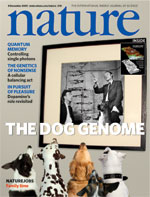|
From rxpgnews.com Evolution
An international research team led by scientists at the Broad Institute of MIT and Harvard announced today the completion of a high-quality genome sequence of the domestic dog, together with a catalogue of 2.5 million specific genetic differences across several dog breeds. Published in the December 8 issue of Nature, the dog research sheds light on both the genetic similarities between dogs and humans and the genetic differences between dog breeds.
Comparison of the dog and human DNA reveals key secrets about the regulation of the master genes that control embryonic development. Comparison among dogs also reveals the structure of genetic variation among breeds, which can now be used to unlock the basis of physical and behavioural differences, as well the genetic underpinnings of diseases common to domestic dogs and their human companions. "Of the more than 5,500 mammals living today, dogs are arguably the most remarkable," said senior author Eric Lander, director of the Broad Institute, professor of biology at MIT and systems biology at Harvard Medical School, and a member of the Whitehead Institute for Biomedical Research. "The incredible physical and behavioural diversity of dogs -- from Chihuahuas to Great Danes � is encoded in their genomes. It can uniquely help us understand embryonic development, neurobiology, human disease and the basis of evolution." Dogs not only occupy a special place in human hearts, they also sit at a key branch point in the evolutionary tree relative to humans. By tracking evolution's genetic footprints through the dog, human and mouse genomes, the scientists found that humans share more of their ancestral DNA with dogs than with mice, confirming the utility of dog genetics for understanding human disease. Most importantly, the comparison revealed the regions of the human genome that are most highly preserved across mammals. "The clustering of regulatory sequences is incredibly interesting," said Kerstin Lindblad-Toh, first author of the Nature paper and co-director of the genome sequencing and analysis program at Broad. Dogs were domesticated from gray wolves as long as 100,000 years ago, but selective breeding over the past few centuries has made modern dog breeds a testament to biological diversity. Efforts to create the genetic tools needed to map important genes in dogs have gained momentum over the last 15 years, and already include a partial survey of the poodle genome. First, they acquired high-quality DNA sequence from a female boxer named "Tasha," covering nearly 99% of the dog's genome. By comparing these dogs, they pinpointed ~2.5 million individual genetic differences among breeds, called single nucleotide polymorphisms (SNPs), which serve as recognizable signposts that can be used to locate the genetic contributions to physical and behavioural traits, as well as disease. Finally, the scientists used the SNP map to reconstruct how intense dog breeding has shaped the genome. They discovered that selective breeding carried large genomic regions of several million bases of DNA into breeds, creating 'haplotype blocks' that are ~100 times larger than seen in the human population. "The huge genomic regions should make it much easier to find the genes responsible for differences in body size, behaviour and disease," said Lander. "Such studies will need many fewer markers than for human studies. Breeding programs not only selected for desired traits, they also had the unintended consequence of predisposing many dog breeds to genetic diseases, including heart disease, cancer, blindness, cataracts, epilepsy, hip dysplasia and deafness. With the dog genome sequence and the SNP map, scientists around the world now have the tools to identify these disease genes.
"The genetic contributions to many common diseases appear to be easier to uncover in dogs," said Lindblad-Toh. "If so, it is a significant step forward in understanding the roots of genetic disease in both dogs and humans." For this work, the dog-owner community is an essential collaborator. "We deeply appreciate the generous cooperation of individual dog owners and breeders, breed clubs and veterinary schools in providing blood samples for genetic analysis and disease gene mapping," said Lindblad-Toh. All rights reserved by www.rxpgnews.com |

